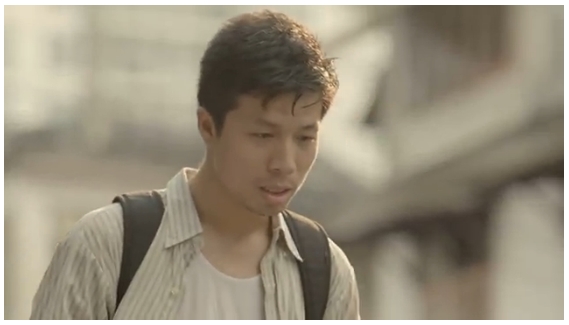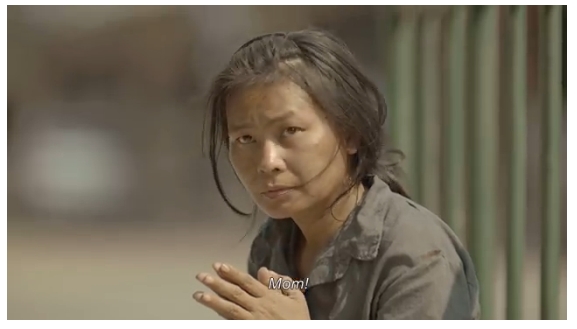Your Reader DOESN’T GET TO WATCH
the Video You’re Analyzing
When I ask you to analyze a visual argument from film or video, imagine you are describing the images to a reader who can’t see what you’re describing. You may understand the creator’s intentions and the complexities of the narrative, but since you’ve learned them from watching the visuals, the reader will have no basis to evaluate your judgements unless you describe the visible components of the Visual Argument.
For readers who are not watching along with you, you are not sharing what needs to be shared by saying: “since he has no money.” We don’t understand how you know this, and therefore we can’t trust your conclusion. Much more effective and to the point, explain that “he turns out his empty pockets to indicate he has no money.” Now we’ll understand what part of the argument was conveyed by the images.
Evaluate the Rhetoric
It’s also your responsibility to indicate whether the technique (the rhetorical part of the visual argument) is effective or not. One of the images below conveys cashlessness without unnecessary distractions. No money, pure and simple. The others inject extraneous and potentially confusing notes of sensuality or degradation. One is rhetorically singular. The others may be effective, but only if the cashless person is supposed to be shapely, or fit, or seedy, or disturbing.



As viewers, we’ve been trained to be widely receptive to the nuances of images. The best communicators limit the range of interpretations we can impose. When it’s your turn to analyze a visual, you’ll need to gauge how effectively the intended messages are delivered, how much the noise has been reduced.
Sample Argument Analysis
Let’s examine just ten seconds of vid-caps from a sample video and see how much we can extract from looking at a portion of an argument we don’t already know.
Looking at silent stills from the video this way, without knowing the context, and without the distractions of the soundtrack or narrative significance, we’ll have to concentrate exclusively on the images alone, at the rate of one per second, to see how we’re being manipulated.
 1:44
1:44
A young Asian man, probably outdoors in a city, is dressed casually and wears a backpack. He is either not well shaved or has deliberately chosen the unshaven look for fashion’s sake. His hairstyle is neat but casual and his open shirt and undershirt are clean, so the impression we get is that he is not poor or homeless but that he chooses to dress for an informal effect. He carries a pen in his pocket: industrious or at least prepared. He is looking down, either to see the curb, or something on the sidewalk, or at least something below eye level, perhaps in his hand.
 1:45
1:45
By this frame, we’re seeing a hint of something brown and rectangular in his hands. Our immediate impression is that it’s a wallet but we can’t be sure. Passport? Map? It is clearly occupying his attention, but also he is still walking, so he must know where he’s going; otherwise, he’d have to be more careful stepping. So: will he be spending money on something he routinely buys?
 1:46
1:46
Here, instead of seeming to be involved in a routine, the man looks surprised. His open mouth might indicate he wants to ask a question. His narrowed eyes give the impression he wants to focus carefully to make sure he’s seeing what he thinks he’s seeing. That combination of confusion and disorientation might indicate he is worried about what he’s seeing.
 1:47
1:47
A woman is looking up. We assume she is looking at him, and that, given the angle of their communication, she must be standing in a deep hole, or seated on the ground, sidewalk, or curb before a pedestrian barrier that subtly suggests prison bars. Is she trapped or confined?
The fact that he walked right up to her without worrying about where he was going indicates he is accustomed to finding her here (and perhaps that he uses his wallet when they meet).
She is perhaps his age or a bit older, not much. She is not disheveled or unclean, but neither is she fashionable or “put together.” Her drab open-collar shirt might even indicate she’s poor. She is clearly quite troubled from the furrowed brow and pressed eyebrows. Her hands are folded too. Has he interrupted her at prayers? Or is she asking (begging) for something from him?
 1:48
1:48
The camera pans down to reveal that she is in fact sitting on the ground, more specifically on a piece of cardboard torn from a shipping carton as we can tell from the torn die-cut handle. In other words, she’s sitting on some trash she brought here for this purpose. The cardboard is wider than it needs to be for her. Next to her is what we might call, an “empty seat.” Is she perhaps waiting for him to join her? Or has she lost someone? Is it possible he has always given her money (the wallet? the sure steps in her direction?) and that her being alone is surprising or disturbing?
But that can’t be. Unless a person just got up from this “seat,” the cardboard wouldn’t be folded out to the woman’s left. She’d fold it under herself. What can it mean? Did someone just disappear from this street corner?
It would have to be someone intimate, even related. Friends or acquaintances would have their own cardboard; they wouldn’t share.
 1:49
1:49
The word “Mom!” appears as a subtitle, with an exclamation mark! Not a label, then, but someone’s call. Somebody is calling Mom. Oh no. Has the man’s mother always sat here on this bit of cardboard where the man visits her often, but today she’s gone, sick, injured, missing? If she’s dead would the cardboard still be there? If she’s nearby, what has happened?
 1:50
1:50
The woman, hands still folded, looks up. Has she heard someone call Mom? The implication is that she might be responding to the call, but does that mean she’s Mom? Or that she’s looking to see who might be calling out? The man, we presume is still directly in front of her, so she’s looking off to the side, not at him.
 1:51
1:51
When the man spins to his right, he is clearly looking down the sidewalk. The woman, when she looked up and turned to her left, must have been looking down that same sidewalk. His mouth is still open. He still has unanswered questions. His eyes are focused on the distance so we guess he’s looking at someone standing fifty feet away or coming in his direction. Is it the person who called out Mom? The woman’s child?
 1:52
1:52
It’s a schoolgirl in an unmistakable schoolgirl uniform. The bit of stitching above the pockets is probably the name of the school. Like the man and woman, she’s Asian, a girl of six or seven maybe? An early elementary school child.
Her untucked shirt and the straps of her blue backpack are clear echoes of the young man’s outfit. Maybe that’s why he has a pen in his pocket. He could be her teacher.
But her shirt is neatly pressed, maybe the nicest garment in the video. It cost money to buy and to keep clean. The school she goes to costs money. Does the man (her teacher?) pick up this child on the way to school every morning? Was she just momentarily away from the corner on an errand? She called out Mom!, we now assume, but in the right of the frame, the man’s clothes are visible.
She could have seen him as well as her mother on the ground. So this can’t be Dad, right? Unless she now calls out Dad! She looks radiantly happy. Is she just a joyous adorable child, or has she been separated from Mom and happy to be back?
This shot confirms we are in a city. The row of barred barriers at the curb echo the one behind Mom on the sidewalk. They either protect pedestrians from runaway cars or they’re a place to lock up bikes.
The girl’s hands are empty, so she hasn’t been sent on an errand to fetch something for Mom. Is she possibly coming back from school? Good God, what if this bit of cardboard is home? How would she stay so clean?
 1:53
1:53
She stops dead in her tracks on the sidewalk in reaction to something not frightening but important. She doesn’t turn and flee or seem afraid. She doesn’t look back and forth from Mom to the man and back; she can handle this on her own. But she doesn’t proceed any further forward either. She is processing something at this distance. From the angle of her eyes, we know she’s looking not at Mom but at the face of the standing man.
 1:54
1:54
The camera is moving slowly in her direction. Since we are seeing her from the man’s perspective, this means we are “taking a closer look at her,” moving carefully from the distant stranger position to a closer proximity where we are comfortable with people we know.
If this is her customary spot on the cardboard, the man must have been disturbed to see her missing. Now that she’s here, we should expect to see relief if we get another look at him.
 1:55
1:55
What’s going on here? He looks just as confused as ever. Is he relieved to see the child he was worried was missing, gone, or hurt? Why is he not smiling at the sight of her? If he’s her Dad, this is a very inappropriate facial expression. But clearly she’s not meaningless to him. He has an interest in her.
Conjectures, please.
The Argument in Context
Now, let’s watch the argument in its entirety to test our hypotheses.
Review and Recommendation
This analysis of just ten seconds of video will remind you, I hope, what a rich medium is video for argument. We have discussed countless implications of the contents of individual frames, all of which are small claims in a larger argument. We can’t be sure how we’re being manipulated until we understand the entire argument, but watching pieces out of context gives us the best opportunity to see the mechanics of argument at work. When we watch in the “proper” sequence, with the “appropriate” soundtrack, we can be sure we’re being manipulated, and that we’re willing conspirators in our own persuasion. We’re hoping for a rewarding experience. Do we get goosebumps, or choke up with emotion, after 2 minutes of wordless video about total strangers? That doesn’t happen by accident. That happens when we’ve been persuaded by an argument to believe that something has happened (or that it at least represents a human experience that could happen).
- As you prepare your Visual Argument, watch the videos WITHOUT SOUND, as if you didn’t already know the argument.
- Consider what a single frame communicates without its full context (which has been supplied to you by the video’s creator, whose job is to persuade you).
- Create your own posts to include this degree of analysis and interpretation.
What is the Argument’s Purpose?
The text at the conclusion says:
Thai Life Insurance. Believe in Good.
So, is it a public service announcement that urges us to make small differences in the world we pass through every day? No. It is not. It’s an ad for life insurance.
Make no mistake, this message from an insurance company is designed to sell men a life insurance policy to protect their children.
I admit, that sounds like an outrageous claim. You watched the video. You most likely didn’t feel you were being encouraged to buy life insurance. I didn’t either. WHILE I WAS WATCHING IT. While I was watching it, I was compelled to follow the logic of the narrative; I was swept along by the soundtrack, instructed when and what to feel; I was manipulated into seeing the patterns in the repeated images: three times the bananas on the doorknob. And so on. I was being taught something unwittingly.
Given time to reflect, though, I have decided this:
Paying for a life insurance policy every month, which does me “no direct good,” but which benefits my dependents when I’m gone . . .
is VERY MUCH like:
performing small but significant acts of generosity—such as making regular cash contributions from a light wallet with no tangible benefit for myself—for a little girl whose mother sits alone on a piece of cardboard with no father in sight and a dependent daughter to put through school.
That’s right. The young man is “paying premiums” that add up to a cash benefit for the girl whose father is gone. The young man is the stand-in for the father who dies but who has left behind a life policy with a death benefit that will put her through school.
That’s why the emotional payoff of the piece hits first when the man realizes he has helped “his little girl” get her education when there’s no one there to sit next to Mom.
OK? Get to work. Tell me a story like that one about the video you choose to analyze.
